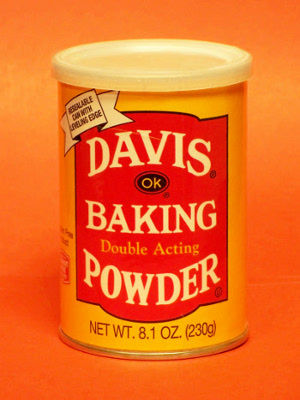Baking Powder's Harvard Pedigree
May 1, 2012
They say that "
you are what you eat," so all of us should be
chemists by now. Although everything is
chemical, we tend to think of
food in a different sense, and we're concerned about the other chemicals that are added to food. Aside from specific
additive and
contaminant scares, such as
cyclamates and
certain chemical residues, our food supply is rather safe; perhaps safer, if you refrain from
fatty and
hormone-saturated
meat.
The US
Food and Drug Administration (FDA) oversees food safety in the
United States. They even go as far as to impound
Swiss cheese that's augmented by drilling more holes than those produced by natural aging. On the other hand, the simulacrum called "
cheese food" is still allowed into our homes and
gullets. Nevertheless, the FDA is one of the few federal agencies for which
taxpayer dollars are well spent.
When I was in
high school, we were required to read
muckraking author
Upton Sinclair's novel, "
The Jungle," which included some vivid stories of food
adulteration at the turn of the
twentieth century. This book helped to launch the
Pure Food and Drug Act of 1906, enforced by the
US Department of Agriculture. The Food, Drug, and Insecticide agency was founded in 1927, and it was renamed the Food and Drug Administration in 1930.

Nearly every household has a container of
baking powder, but few know anything about this chemical mixture, other than its use in baking.
The function of baking powder is quite simple. It releases carbon dioxide gas to increase the volume and lessen the density of baked goods; that is, it acts as a leavening agent. I wrote about baking powder in a different context in a recent article (Bubble Rockets, February 13, 2012).
Baking powder is typically a mixture of baking soda (sodium bicarbonate, NaHCO3) and an acid salt in a
starch base. The starch is there to prevent too fast a
reaction. The reaction is simply given as
NaHCO3 + H+ -> Na+ + CO2 + H2O
The baking powder found in my
pantry, as shown in the photograph, is labeled as "Double Acting." Double-acting baking powder is the most common type of baking powder. It contains two
acid salts, one of which reacts immediately upon exposure to
water, and another that reacts only at the high
temperatures found in the
baking oven.
Cream of tartar (potassium bitartrate, KC
4H
5O
6) and
monocalcium phosphate (CaH
4P
2O
8) are the usual low temperature acid salts.[1] The
Davis baking powder pictured uses monocalcium phosphate as the low temperature acid salt, and
sodium aluminum sulfate as the high temperature acid salt.
The
inventor of the first useful baking powder was
Harvard chemist
Eben Norton Horsford, who was the Rumford Professor of the Application of Science to the Useful Arts.[2-3] His professorship was named in honor of the
American physicist,
Benjamin Thompson, also known as Count Rumford. Thompson is best known for his
experiments that demonstrated the
mechanical equivalent of heat.

Eben Norton Horsford
From his dress, we can surmise that the Harvard classrooms were somewhat chilly.
Boston had a record low temperature of -12°F (-24.4°C) in 1951. I wasn't able to find temperature data for Horsford's era.
(Via Wikimedia Commons))
Horsford was a
student of
German chemist
Justus von Liebig, and he became one of the first faculty members of what would become Harvard's
School of Engineering and Applied Sciences. Among his technical contributions was his recommendation of the best
metal for
Boston's water
pipes, a suitable
food ration for
Union troops in the
US Civil War, and a process for the manufacture of
condensed milk that was sold to the
Borden company.[2-3]
In 1854, Horsford found that monocalcium phosphate and sodium bicarbonate was effective combination of chemicals, and in 1869 he improved his formula by the addition of corn starch. Thus, 1869 can be considered to date of the invention of modern baking powder. Horsford and George Wilson established the Rumford Chemical Works in
East Providence,
Rhode Island.
Rumford Baking Powder is still sold today.[2-3]
In 2006, the American Chemical Society designated the Rumford Chemical Works' East Providence, Rhode Island, site a
National Historic Chemical Landmark for the "Development of Baking Powder."[2-3]
References:
- Baking Powder page on Wikipedia.
- Alvin Powell, "Bubble, bubble, without toil or trouble," Harvard News Office Article, April 5, 2012.
- Alvin Powell, "Bubble, bubble, without toil or trouble," Harvard Gazette, April 5, 2012.
Permanent Link to this article
Linked Keywords: You are what you eat; chemist; chemical compound; chemical; food; food additive; contamination; contaminant; cyclamate; Alar; daminozide; fat; hormone; meat; Food and Drug Administration; United States; Swiss cheese; processed cheese; cheese food; esophagus; gullet; taxpayer dollars; high school; muckraker; Upton Sinclair; The Jungle; adulterant; adulteration; twentieth century; Pure Food and Drug Act; US Department of Agriculture; baking powder; baking; carbon dioxide gas; volume; density; leavening agent; sodium bicarbonate; acid salt; starch; reaction; pantry; water; temperature; baking oven; potassium bitartrate; cream of tartar; monocalcium phosphate; Davis baking powder; sodium aluminum sulfate; invention; inventor; Harvard; Eben Norton Horsford; American; physicist; Benjamin Thompson; experiment; mechanical equivalent of heat; Boston; Wikimedia Commons; student; German; Justus von Liebig; School of Engineering and Applied Sciences; metal; Boston; pipe; food ration; Union Army; Union troops; US Civil War; condensed milk; Borden company; East Providence; Rhode Island; Rumford Baking Powder; National Historic Chemical Landmark.